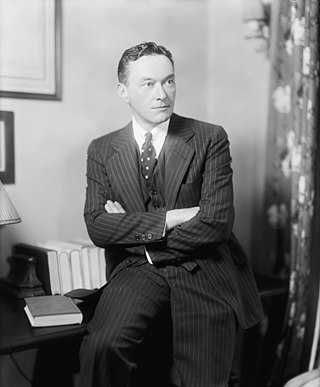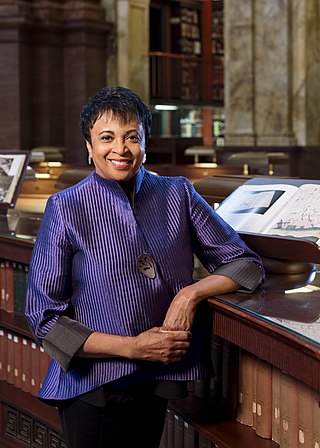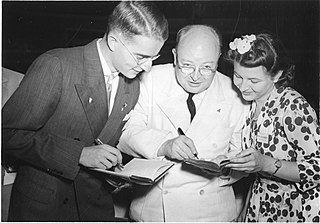Related Research Articles

The Union of International Associations (UIA) is a non-profit non-governmental research institute and documentation center based in Brussels, Belgium, and operating under United Nations mandate. It was founded in 1907 under the name Central Office of International Associations by Henri La Fontaine, the 1913 Nobel Peace Prize laureate, and Paul Otlet, a founding father of what is now called information science.

World Brain is a collection of essays and addresses by the English science fiction pioneer, social reformer, evolutionary biologist and historian H. G. Wells, dating from the period of 1936–1938. Throughout the book, Wells describes his vision of the World Brain: a new, free, synthetic, authoritative, permanent "World Encyclopaedia" that could help world citizens make the best use of universal information resources and make the best contribution to world peace.

Walter Lippmann was an American writer, reporter, and political commentator. With a career spanning 60 years, he is famous for being among the first to introduce the concept of the Cold War, coining the term "stereotype" in the modern psychological meaning, as well as critiquing media and democracy in his newspaper column and several books, most notably his 1922 Public Opinion.

The Vatican Apostolic Library, more commonly known as the Vatican Library or informally as the Vat, is the library of the Holy See, located in Vatican City, and is the city-state's national library. It was formally established in 1475, although it is much older—it is one of the oldest libraries in the world and contains one of the most significant collections of historical texts. It has 75,000 codices from throughout history, as well as 1.1 million printed books, which include some 8,500 incunabula.

Paul Marie Ghislain Otlet was a Belgian author, entrepreneur, lawyer and peace activist; predicting the arrival of the internet before World War II, he is among those considered to be the father of information science, a field he called "documentation". Otlet created the Universal Decimal Classification, which would later become a faceted classification. Otlet was responsible for the development of an early information retrieval tool, the "Repertoire Bibliographique Universel" (RBU) which utilized 3x5 inch index cards, used commonly in library catalogs around the world. Otlet wrote numerous essays on how to collect and organize the world's knowledge, culminating in two books, the Traité de Documentation (1934) and Monde: Essai d'universalisme (1935).
The Association for Information Science and Technology (ASIS&T) is a nonprofit membership organization for information professionals that sponsors an annual conference as well as several serial publications, including the Journal of the Association for Information Science and Technology (JASIST). The organization provides administration and communications support for its various divisions, known as special-interest groups or SIGs; provides administration for geographically defined chapters; connects job seekers with potential employers; and provides organizational support for continuing education programs for information professionals.

Microforms are scaled-down reproductions of documents, typically either films or paper, made for the purposes of transmission, storage, reading, and printing. Microform images are commonly reduced to about 4% or 1⁄25 of the original document size. For special purposes, greater optical reductions may be used.

The International Encyclopedia of Unified Science (IEUS) was a series of publications devoted to unified science. The IEUS was conceived at the Mundaneum Institute in The Hague in the 1930s, and published in the United States beginning in 1938. It was an ambitious project that was never completed.
The International Federation for Information and Documentation (FID) was an international organization that was created to promote universal access to all recorded knowledge through the creation of an international classification system. FID stands for the original French Fédération internationale de documentation.
Herman Howe Fussler was an American librarian, library administrator, teacher, writer and editor, who was a pioneer in the use of microphotography. Fussler was ranked as one of the "100 of the Most Important Leaders we had in the 20th Century" by American Libraries. Fussler served as director of the University of Chicago libraries from 1948 to 1971, was Dean of the University of Chicago Graduate Library School, from 1961 to 1963, and was instrumental in the founding of the Regenstein Library. He helped create the Center for Research Libraries. He was an elected fellow of the American Academy of Arts and Sciences and the American Association for the Advancement of Science.

Julien Cain was the general administrator of the Bibliothèque nationale de France before the Occupation of France by Nazi Germany.

Joseph Michael Reagle Jr. is an American academic and writer focused on digital technology and culture, including Wikipedia, online comments, geek feminism, and life hacking. He is Associate Professor of Communication Studies at Northeastern University. He was an early member of the World Wide Web Consortium, based at the Massachusetts Institute of Technology, and in 1998 and 2010 he was a fellow at Harvard University's Berkman Klein Center for Internet & Society.

Documentation science is the study of the recording and retrieval of information. Documentation science gradually developed into the broader field of information science.

The University of Chicago Graduate Library School (GLS) was established in 1928 to develop a program for the graduate education of librarians with a focus on research. Housed for a time in the Joseph Regenstein Library, the GLS closed in 1989 when the University decided to promote information studies instead of professional education.. GLS faculty were among the most prominent researchers in librarianship in the twentieth century. Alumni of the school have made a great impact on the profession including Hugh Atkinson, Susan Grey Akers, Bernard Berelson, Michèle Cloonan, El Sayed Mahmoud El Sheniti, Eliza Atkins Gleason, Frances E. Henne, Virginia Lacy Jones, William Katz Judith Krug, Lowell Martin, Miriam Matthews, Kathleen de la Peña McCook, Elizabeth Homer Morton, Benjamin E. Powell, W. Boyd Rayward, Charlemae Hill Rollins, Katherine Schipper, Ralph R. Shaw, Spencer Shaw, Peggy Sullivan, Maurice Tauber and Tsuen-hsuin Tsien.

Watson Davis (1896–1967) was the founder of the American Documentation Institute (ADI), the forerunner of the Association for Information Science and Technology, and a pioneer in the field of Library and Information Science.
Robert Cedric Binkley (1897–1940) was an American historian. As chair of the Joint Committee on Materials for Research of the Social Science Research Council and the American Council of Learned Societies in the 1930s he led several projects in the areas of publication using new near-print technologies, microphotography, copyright and archival management, many under the aegis of the Works Progress Administration. His theoretical writings on amateur scholarship and the ways non-experts could contribute to scholarship have been influential on recent thinking about digital humanities and web publishing.

The International Association of Music Libraries, Archives and Documentation Centres (IAML), also known as Association Internationale des Bibliothèques, Archives et Centres de Documentation Musicaux (AIBM) and Internationale Vereinigung der Musikbibliotheken, Musikarchive und Musikdokumentationszentren (IVMB), is an organisation of libraries with music departments, music conservatory libraries, radio and orchestra archives, university institutes, music documentation centers, music publishers, and music dealers that fosters international cooperation and promotes music bibliography and music library science. It was founded in Paris in 1951 and its three official languages are English, German, and French.

Tsien Tsuen-hsuin, also known as T.H. Tsien, was a Chinese-American bibliographer, librarian, and sinologist who served as a professor of Chinese literature and library science at the University of Chicago, and was also curator of its East Asian Library from 1949 to 1978. He is known for studies of the history of the Chinese book, Chinese bibliography, paleography, and science and technology, especially the history of paper and printing in China, notably Paper and Printing, Volume 5 Pt 1 of British biochemist and sinologist Joseph Needham's Science and Civilisation in China. He is also known for risking his life to smuggle tens of thousands of rare books outside of Japanese-occupied China during World War II.
References
- ↑ Rayward, W. Boyd. (1983) “The International Exposition and the World Documentation Congress, Paris 1937.” The Library Quarterly 53.3 (1983): 254–268.
- 1 2 Richards, Pamela Spence (1994). Scientific information in wartime: the Allied-German rivalry, 1939-1945. Greenwood Publishing Group. p. 15. ISBN 978-0-313-29062-6 . Retrieved 11 October 2011.
- ↑ Barua, Brahmanda Pratap (1992). National policy on library and information systems and services for India: perspectives and projections. Popular Prakashan. p. 63. ISBN 978-81-7154-730-2 . Retrieved 11 October 2011.
- ↑ Rayward, W. B.(1981). Evolution of an international library and bibliographic community. Journal of Library History, 16, 449–462.
- ↑ Rabinovitz, Lauren; Geil, Abraham (February 2004). Memory bytes: history, technology, and digital culture. Duke University Press. p. 81. ISBN 978-0-8223-3241-1 . Retrieved 11 October 2011.
- ↑ Ockenfeld, Marlies; Samulowitz, Hansjoachim (2004). "Libraries and Documentation in Germany: A Long-lasting Conflict". The History and Heritage of Scientific and Technological Information Systems. Information Today, Inc. p. 314ff. Retrieved 11 October 2011.
- ↑ Kent, Allen (27 February 1985). Encyclopedia of library and information science. CRC Press. p. 15. ISBN 978-0-8247-2038-4 . Retrieved 11 October 2011.
- 1 2 Buckland, Michael Keeble (April 2006). Emanuel Goldberg and his knowledge machine: information, invention, and political forces. Greenwood Publishing Group. p. 183ff. ISBN 978-0-313-31332-5 . Retrieved 11 October 2011.
- ↑ Reagle, Joseph Michael; Lessig, Lawrence (30 September 2010). Good Faith Collaboration: The Culture of Wikipedia . MIT Press. p. 26. ISBN 978-0-262-01447-2 . Retrieved 11 October 2011.
- 1 2 "The World Congress of Universal Documentation". Science. 86 (2231): 303–304. 1 October 1937. doi:10.1126/science.86.2231.303-a. JSTOR 1665491.
- ↑ "Unpublished Manuscript to Be Accessible to Scholars". The Science News-Letter. 32 (854): 124. 21 August 1937. doi:10.2307/3913966. JSTOR 3913966.
- ↑ Davis, Watson (9 October 1937). "How Documentation Promotes Intellectual World Progress". The Science News-Letter. 32 (861): 229–231. doi:10.2307/3913336. JSTOR 3913336.
- ↑ Fussler, Herman H.. “American Microphotography at the Paris Exposition.” American Library Association Bulletin 32.2 (1938): 104–106.
- ↑ Wells, H.G. (9 October 1937). "Today's Distress and Horrors Basically Intellectual: Wells". The Science News-Letter. 32 (861): 229. doi:10.2307/3913335. JSTOR 3913335.
- ↑ "Documentation Congress Step toward Making 'World Brain'". The Science News-Letter. 32 (861): 228–9. 9 October 1937. doi:10.2307/3913334. JSTOR 3913334.
- ↑ Day, Ronald E. (7 February 2008). The Modern Invention of Information: Discourse, History, and Power. SIU Press. p. 21. ISBN 978-0-8093-2848-2 . Retrieved 11 October 2011.
- 1 2 Wedgeworth, Robert (1 January 1993). World Encyclopedia of Library and Information Services. ALA Editions. p. 644. ISBN 978-0-8389-0609-5 . Retrieved 11 October 2011.